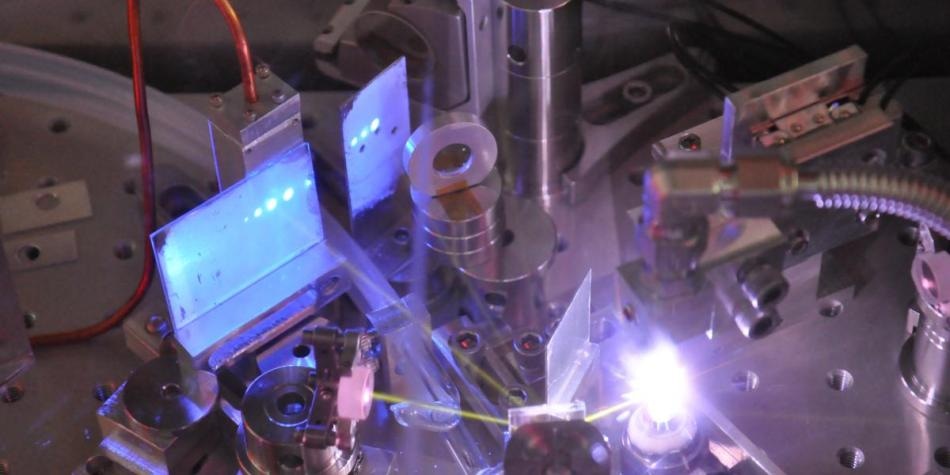Dec 11 2019
Scientists have successfully recorded the interactions between an electron and specific atomic vibrations in a solid, in a frame-by-frame fashion. This is the first-ever study to achieve this breakthrough.
 Ultrafast pulses of ultraviolet light in a gas jet are visible as blue dots on a phosphor screen. Image Credit: Research2Reality.
Ultrafast pulses of ultraviolet light in a gas jet are visible as blue dots on a phosphor screen. Image Credit: Research2Reality.
The new method involves recording a process that often induces electrical resistance in materials while inducing the exact opposite in other materials—that is, superconductivity, or the lack of resistance.
The way electrons interact with each other and their microscopic environment determines the properties of all solids. Once we identify the dominant microscopic interactions that define a material’s properties, we can find ways to ‘turn up’ or ‘down’ the interaction to elicit useful electronic properties.
MengXing Na, Study Co-Lead Author and PhD Student, University of British Columbia
The study was recently published in the Science journal.
It is crucial to control these interactions to technologically manipulate quantum materials, such as superconductors. Superconductors are utilized in high-speed magnetic levitation trains, MRI machines, and, in the future, could transform the way energy is delivered.
Atoms in all solids tend to vibrate continuously at tiny scales. When an electron collides with an atom, a “scattering” event is seen between the vibration and the electron, known as a phonon. This scattering can force the electron to alter its energy as well as its direction. Such interactions between electrons and phonons lie at the core of a majority of the unusual phases of matter, where materials exhibit special characteristics.
The researchers at the Stewart Blusson Quantum Matter Institute (SBQMI) of UBC created a novel extreme-ultraviolet laser source to facilitate a method, known as time-resolved photoemission spectroscopy, for envisaging the processes of electron scattering at ultrafast timescales. The research team was financially supported by the Gordon and Betty Moore Foundation.
Using an ultrashort laser pulse, we excited individual electrons away from their usual equilibrium environment. Using a second laser pulse as an effective camera shutter, we captured how the electrons scatter with surrounding atoms on timescales faster than a trillionth of a second.
MengXing Na, Study Co-Lead Author and PhD Student, University of British Columbia
Na continued, “Owing to the very high sensitivity of our setup, we were able to measure directly—for the first time—how the excited electrons interacted with a specific atomic vibration, or phonon.”
The scientists carried out the experiment on graphite—the parent compound of graphene, carbon nanotubes, and Buckyballs and a crystalline form of carbon.
Carbon-based electronics is a thriving sector, and the scattering processes contributing to electrical resistance may restrict their use in nanoelectronics.
The method exploits a special laser facility developed by the study’s co-lead author Arthur Mills and conceived by David Jones and Andrea Damascelli at the UBC-Moore Centre for Ultrafast Quantum Matter.
The research was also supported by theoretical associations with the groups of Alexander Kemper at North Carolina State University and Thomas Devereaux at Stanford University.
“Thanks to recent advances in pulsed-laser sources, we’re only just beginning to visualize the dynamic properties of quantum materials,” stated Jones, a professor with UBC’s SBQMI and Department of Physics and Astronomy.
By applying these pioneering techniques, we’re now poised to reveal the elusive mystery of high-temperature superconductivity and many other fascinating phenomena of quantum matter.
Andrea Damascelli, Scientific Director, Stewart Blusson Quantum Matter Institute, University of British Columbia
The Gordon and Betty Moore Foundation’s EPiQS Initiative (Grant GBMF4779 to A.D. and D.J.J.), Canada Foundation for Innovation, the Natural Sciences and Engineering Research Council, the Canada First Research Excellence Fund, and the B.C. Knowledge Development Fund supported the study.